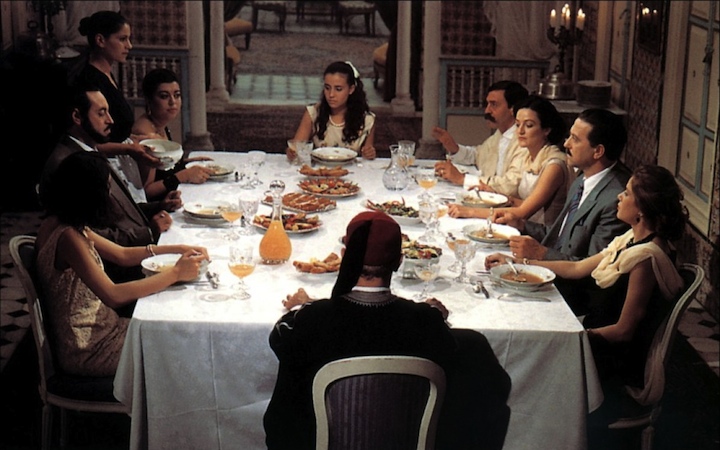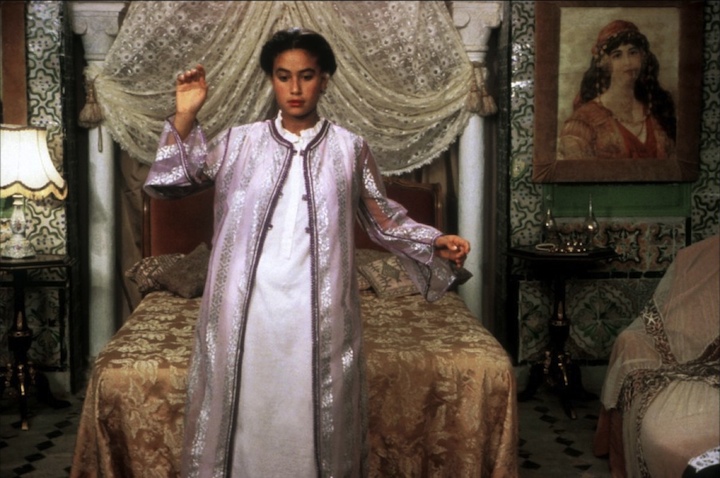Silences of the Palace [Samt al-Qusur], directed by Moufida Tlatli. France/Tunisia, 1994.
As a lover of film, I am often asked about my favorites. And as a lover of Arab film in particular, I am usually expected by friends and colleagues to begin with a paean to the Egyptian cinema. Growing up in the home of an Egyptian immigrant to Canada, I was weaned on a steady diet of Fatin Hamama, Rushdy Abaza, and Samia Gamal, and perhaps unsurprisingly, the cinema of the 1950s and the 1960s became a passion. I could never get fired up about the fluff of the forties, and the schlock of the seventies always seemed to pale in comparison to the “gritty glamour” of the fifties and sixties, the cinema Joel Gordon has fondly described as “revolutionary melodrama.” It comes as no surprise, then, that such classics as The Nightingale’s Prayer (Duaa al-Karawan), Sleepless (La Anam), and I Am Free (Ana Hurra) should secure ranks in my “top ten.”
However, the film ranked at number one usually generates, if not an expression of surprise, either a suspicious glance or a blank stare. When pressed to name my favorite film, I offer Moufida Tlatli’s masterpiece Silences of the Palace (Samt al-Qusur)—a Tunisian film released in 1994. Seventeen years after its release, Silences remains lamentably little known, even among those who have a better than passing familiarity with Arab film. From a practical standpoint, of course, the lack of a North American DVD release necessarily limits the film’s renown. But Silences is a challenging film as well, and that may explain the film`s scarcity. I hasten to clarify that the film, while challenging, is not “difficult.” Indeed, the film is so accessible that I regularly show it to undergraduates. By “challenging,” I mean that Silences is an unflinching and ultimately heart-rending account of violence of various sorts—the violence of patriarchy, the violence of colonialism, the violence of poverty.
The story, conveyed as a series of flashbacks, unfolds within the confines of the palace of a Tunisian notable family. A young woman, Alia, who now plies her trade as a wedding singer, has returned to the palace after an absence of many years. The household is mourning the death of one of the men of the family, and Alia has apparently come to pay her respects. But the return to the palace prompts a flood of memories from the young woman’s childhood, which she spent in the palace alongside her mother, Khedija, who was one of the family’s servants. Importantly, her childhood in the palace dates to the waning days of French influence in Tunis, and the rise of the independence movement.
There is so much that is remarkable about Silences that one hardly knows where to begin. Simply in terms of sets, decor, and costumes, the film is astounding: the utterly opulent lifestyle of the notables upstairs is contrasted starkly with the spartan conditions in which the servants dwell downstairs. Silences is one of the few films I know that so powerfully captures, in distinctly material terms, the decadence of the pre-independence notable class, and sets that decadence immediately alongside the hardships of the poor. The original oud music that dominates the film, composed by the virtuoso Anouar Brahem, is hauntingly beautiful, and remains in the mind long after the theater curtains are drawn.

[Still Image from "Silences of the Palace."]
But the genius of the film lies in the meticulous crafting of the plot, which establishes a parallel between the “coming of age” of Alia, struggling with various layers of her identity, and the rise of an independent Tunisia. Western reviews of the film on the festival circuit tended to focus upon the dynamics of sexual oppression with which Alia finds herself confronted, as she emerges from puberty into womanhood. Her mother, subject to the harassment and abuse of the men “upstairs,” is reluctant to speak with Alia of her father. One comes to grasp in the course of the film that Alia’s father in fact resides upstairs, while her mother remains relegated to the servant’s quarters downstairs, leaving Alia in a quandary as to where she belongs—with her friend Sara, one of the “legitimate” children of the notable family, or with the rest of the servants below? When Alia happens upon the brutal sexual assault of her mother by one of the notables, she is quite literally stunned into silence, dumbfounded by the violence that the power imbalance between upstairs and downstairs, and between men and women, occasions.
However, one swiftly discovers that Silences is no simplistic allegory of the condition of women in pre-independence Tunisia. Indeed, as Nouri Gana has argued in these pages (and here I draw upon his analysis), what makes the film particularly relevant in the context of the Arab uprisings and, of course, Tunisia’s central role therein, is the critique of the post-independence regimes conveyed most powerfully in the film’s final lines. In Alia’s flashbacks, one is introduced to Lotfi, an activist for the nationalist cause, who is hired by the notables as a schoolteacher. It is Lotfi who, in a moment of great allegorical weight, teaches Alia to write her name. But Lotfi ends up failing Alia much as her father had: the schoolteacher had promised the young woman freedom from her bondage in the palace and a career as a great singer. At the end of the film, as she wanders in the palace courtyard, the Alia of post-independence Tunisia casts her mind back to her long-dead mother, and laments her continued bondage:
I thought that Lotfi would save me
I have not been saved
Like you, I’ve suffered, I’ve sweated
Like you, I’ve lived in sin
My life has been a series of abortions
I could never express myself
My songs were stillborn
And even the child inside me Lotfi wants me to abort
This child...I feel it has taken root in me
I feel it bringing me back to life
Bringing me back to you
I hope it will be a girl
I’ll call her Khedija

[Still image from "Silences of the Palace."]
I can scarcely imagine a better way to convey to my students what the Arab uprisings are about than to show Silences of the Palace, a film which speaks not only to the struggles of the past but, as palpably revealed in the lines above, to the struggle for the future as well.